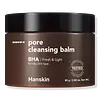What's inside
What's inside
 Key Ingredients
Key Ingredients

 Benefits
Benefits

 Concerns
Concerns

 Ingredients Side-by-side
Ingredients Side-by-side

Ethylhexyl Palmitate
EmollientCetyl Ethylhexanoate
EmollientPEG-20 Glyceryl Triisostearate
EmollientPEG-10 Isostearate
EmulsifyingSynthetic Wax
AbrasiveSimmondsia Chinensis Seed Oil
Emollient1,2-Hexanediol
Skin ConditioningC12-13 Alkyl Lactate
EmollientButylene Glycol
HumectantWater
Skin ConditioningCapryloyl Salicylic Acid
ExfoliatingSalicylic Acid
MaskingMelaleuca Alternifolia Leaf Extract
PerfumingMelaleuca Alternifolia Leaf Oil
AntioxidantMelia Azadirachta Leaf Extract
Skin ConditioningMelia Azadirachta Flower Extract
Skin ConditioningBambusa Vulgaris Extract
Skin ConditioningAspalathus Linearis Extract
Skin ConditioningAngelica Archangelica Root Extract
MaskingMalpighia Emarginata Fruit Extract
Skin ConditioningEthylhexyl Palmitate, Cetyl Ethylhexanoate, PEG-20 Glyceryl Triisostearate, PEG-10 Isostearate, Synthetic Wax, Simmondsia Chinensis Seed Oil, 1,2-Hexanediol, C12-13 Alkyl Lactate, Butylene Glycol, Water, Capryloyl Salicylic Acid, Salicylic Acid, Melaleuca Alternifolia Leaf Extract, Melaleuca Alternifolia Leaf Oil, Melia Azadirachta Leaf Extract, Melia Azadirachta Flower Extract, Bambusa Vulgaris Extract, Aspalathus Linearis Extract, Angelica Archangelica Root Extract, Malpighia Emarginata Fruit Extract
Paraffinum Liquidum
EmollientEthylhexyl Stearate
EmollientCarthamus Tinctorius Seed Oil
MaskingPEG-20 Glyceryl Triisostearate
EmollientCocos Nucifera Oil
MaskingPolyethylene
AbrasiveC13-15 Alkane
SolventOlea Europaea Fruit Oil
MaskingPEG-10 Isostearate
EmulsifyingTrihydroxystearin
Skin ConditioningCitrus Aurantium Dulcis Peel Oil
MaskingLavandula Angustifolia Oil
MaskingTocopheryl Acetate
AntioxidantCitrus Aurantium Bergamia Fruit Oil
MaskingSalicylic Acid
MaskingArgania Spinosa Kernel Oil
EmollientCamellia Japonica Seed Oil
EmollientPrunus Armeniaca Kernel Oil
MaskingSimmondsia Chinensis Seed Oil
EmollientMentha Piperita Oil
MaskingParaffinum Liquidum, Ethylhexyl Stearate, Carthamus Tinctorius Seed Oil, PEG-20 Glyceryl Triisostearate, Cocos Nucifera Oil, Polyethylene, C13-15 Alkane, Olea Europaea Fruit Oil, PEG-10 Isostearate, Trihydroxystearin, Citrus Aurantium Dulcis Peel Oil, Lavandula Angustifolia Oil, Tocopheryl Acetate, Citrus Aurantium Bergamia Fruit Oil, Salicylic Acid, Argania Spinosa Kernel Oil, Camellia Japonica Seed Oil, Prunus Armeniaca Kernel Oil, Simmondsia Chinensis Seed Oil, Mentha Piperita Oil
 Reviews
Reviews

Ingredients Explained
These ingredients are found in both products.
Ingredients higher up in an ingredient list are typically present in a larger amount.
PEG-10 Isostearate isn't fungal acne safe.
Peg-20 Glyceryl Triisostearate comes from Isostearic Acid and glycerin.
It is an emollient, emulsifier, and gentle cleanser. As an emollient, it helps trap moisture to keep skin soft and hydrated. Emulsifiers help prevent ingredients from separating.
This ingredient is common in oil-based products. This is because it helps oil-ingredients be easily washed away without leaving a residue.
Peg-20 Glyceryl Triisostearate may not be fungal-acne safe.
Learn more about PEG-20 Glyceryl TriisostearateSalicylic Acid (also known as beta hydroxy acid or BHA) is a well-known ingredient for treating skin that struggles with acne and clogged pores. It exfoliates both the skin's surface and deep within the pores to help clear out buildup, control oil, and reduce inflammation.
Unlike AHAs (alpha hydroxy acids), salicylic acid is oil-soluble. This allows it to penetrate into pores which makes it especially effective for treating blackheads and preventing future breakouts.
Salicylic acid is also known for its soothing properties. It has a similar structure to aspirin and can calm inflamed or irritated skin, making it a good option for acne-prone skin that is also sensitive.
Concentrations of 0.5-2% are recognized by the U.S. FDA as an over-the-counter topical acne product.
It can cause irritation and/or dryness if one's skin already has a compromised moisture barrier, so it's best to focus on repairing that before introducing this ingredient into your routine.
While salicylic acid does not increase sun sensitivity, it’s still important to wear sunscreen daily to protect your skin.
If you are looking for the ingredient called BHA or Butylated Hydroxyanisole, click here.
Learn more about Salicylic AcidThis oil comes from the seeds of the desert shrub called Jojoba. It is more commonly known as jojoba oil, a non-comedogenic oil.
Jojoba oil does not contain fragrance and has many fatty-acids, making it a great soothing ingredient.
It also contains Vitamin E, a great moisturizing ingredient. Vitamin E is also an antioxidant and protects your skin against oxidative damage.
This ingredient humectant properties, meaning it helps draw moisture from the air. This helps keep your skin hydrated.
While jojoba has antibacterial properties, it is only able to kill some strains of bacteria.
Studies also show it helps in wound healing. In fact, Indigenous cultures have used jojoba as a moisturizer and to help treat burns for centuries.
Fun fact: Jojoba oil similar to natural human skin sebum, so it has a great effect on dry skin. It is also promising with helping to regulate sebum production.
Due to its fatty acid content, Jojoba oil may not be fungal acne safe. We recommend speaking with a professional if you have any concerns.
Learn more about Simmondsia Chinensis Seed Oil